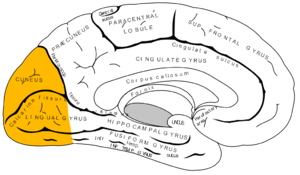Occipital epilepsy
Occipital epilepsy is a neurological disorder that arises from excessive neural activity in the occipital lobe of the brain that may or may not be symptomatic. Occipital lobe epilepsy is fairly rare, and may sometimes be misdiagnosed as migraine when symptomatic. Epileptic seizures are the result of synchronized neural activity that is excessive, and may stem from a failure of inhibitory neurons to regulate properly.[1]
| Occipital epilepsy | |
|---|---|
 | |
| Occipital lobe | |
| Specialty | Neurology |
Signs and symptoms
The most frequently reported symptoms are elementary "visual hallucinations" characterized by basic irritations to perception of sight. Scotomas and amaurosis also occur and are predictors of poor medication response.[2] Hallucinations may be described as flashing small circular patterns or zigzags. Vomiting or temporary blindness may occur and visual seizures may be followed by a headache leading to a frequent misdiagnosis as migraine.[3] Seizures may become generalized.[4]
Diagnosis
Management
Prognosis is generally good, and seizures usually respond to classic antiepileptics.[5] Resection of pathological tissue has been used successfully to treat occipital lobe epilepsy.[6]
References
- Hammer, edited by Stephen J. McPhee, Gary D. (2010). "7". Pathophysiology of disease : an introduction to clinical medicine (6th ed.). New York: McGraw-Hill Medical. ISBN 978-0-07-162167-0.CS1 maint: extra text: authors list (link)
- Kotov, A. S.; Rudakova, I. G.; Belova, Iu A.; Kotov, S. V. (1 January 2009). "[Occipital lobe epilepsy in adults]". Zhurnal Nevrologii I Psikhiatrii Imeni S.S. Korsakova. 109 (7): 4–8. ISSN 1997-7298. PMID 19672230.
- Panayiotopoulos, C. P. (1 December 1999). "Visual phenomena and headache in occipital epilepsy: a review, a systematic study and differentiation from migraine". Epileptic Disorders. 1 (4): 205–216. ISSN 1294-9361. PMID 10937155.
- Chary, Prithika; Rajendran, Bhuvaneshwari (1 January 2013). "Benign occipital lobe seizures: Natural progression and atypical evolution". Annals of Indian Academy of Neurology. 16 (4): 556–560. doi:10.4103/0972-2327.120465. ISSN 0972-2327. PMC 3841599. PMID 24339578.
- Chary, Prithika; Rajendran, Bhuvaneshwari (1 January 2013). "Benign occipital lobe seizures: Natural progression and atypical evolution". Annals of Indian Academy of Neurology. 16 (4): 556–560. doi:10.4103/0972-2327.120465. ISSN 0972-2327. PMC 3841599. PMID 24339578.
- Tandon, Nitin; Alexopoulos, Andreas V.; Warbel, Ann; Najm, Imad M.; Bingaman, William E. (1 February 2009). "Occipital epilepsy: spatial categorization and surgical management". Journal of Neurosurgery. 110 (2): 306–318. doi:10.3171/2008.4.17490. ISSN 0022-3085. PMID 19046038.